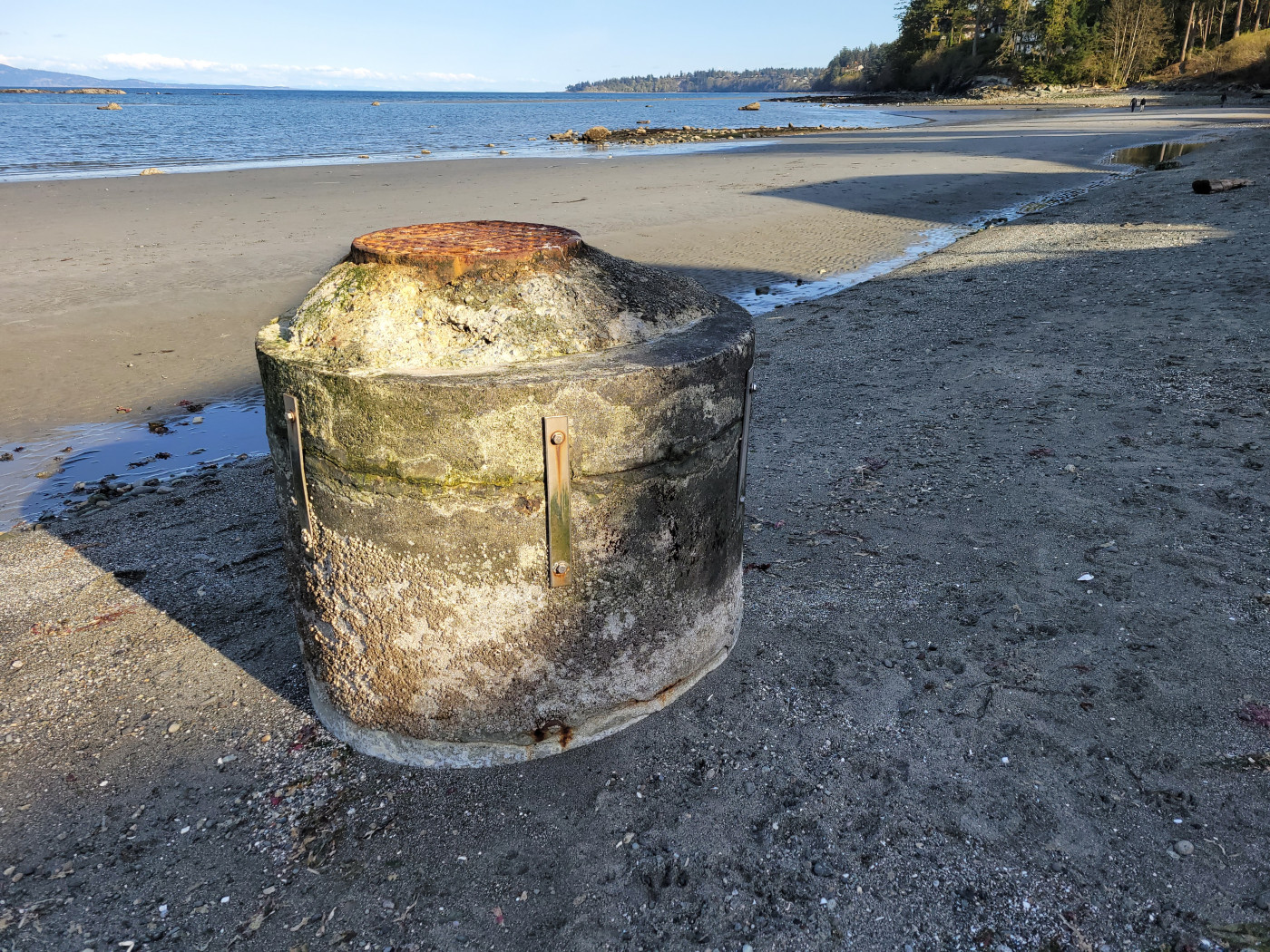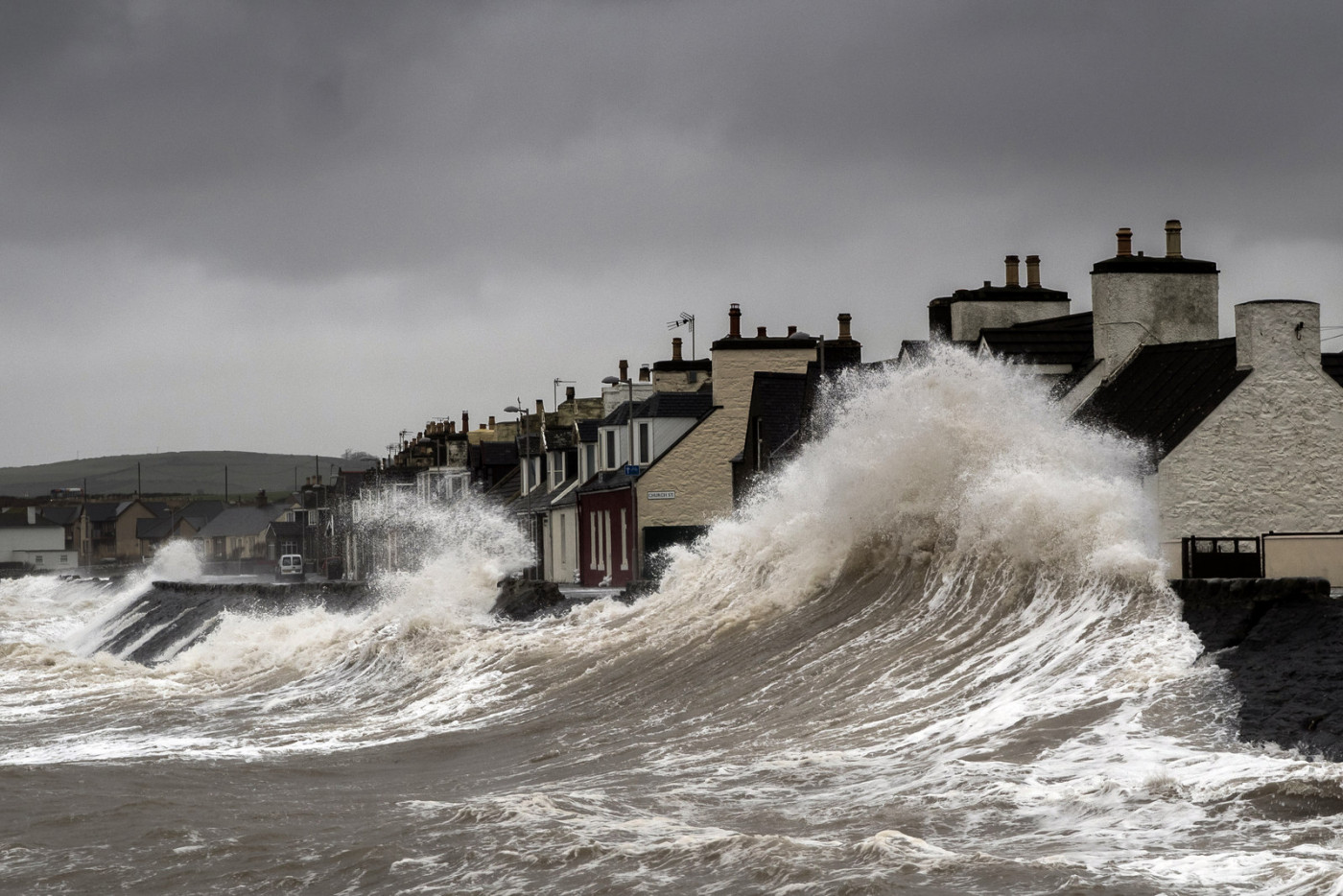Who does not love a trip to the seaside? Yet whether walking along a cliff path or sitting on the beach it does not occur to many people how changeable the coast is. It is an ever-shifting landscape, where cliffs are eroded to become beaches, which are then washed away by storms and tides. While this is a natural process, today, it is happening faster than ever due to human activity, either directly or through anthropogenic climate change. This damages or destroys habitats and threatens approximately 2 billion people who live within 100 km of a coastline 1. Coastal erosion threatens to cause damage across the world, with its effects most likely more impacting poorer communities. Stabilising and protecting our coastlines must therefore be a priority for us all.

A manhole cover on a beach, exposed through the erosion of sand around it. Licensed under Creative Commons, photograph by AkiliDaniels, CC BY-SA 4.0 via Wikimedia Commons. https://commons.wikimedia.org/wiki/File:Cordova_Bay_Manhole_Cover.jpg
The causes of coastal erosion due to human activity are many. First, there are direct threats. Sand is valued in industries such as construction and dredging it off the coast is an efficient way to get lots of it. However, that sand is then not available to form beaches; as they are eroded there is no sand left for renewing the shoreline 2. Furthermore, extracting sand and gravel offshore can impact how waves form and break upon the coast 3, changing the natural deposition process. This sand is not even replenished from rivers, as in many places, large damming projects prevent river sediment from reaching the sea 4. Human development can also put pressure on or completely destroy habitats which protect coastlines, such as forests or coral reefs offshore 5. Thus, the seacreeps ever closer to habitats and human settlement alike, leaving them vulnerable to flooding or collapse.
Second are the threats caused by climate change that accelerate the effects of erosion. The rise in temperatures around the world has created conditions for more frequent, more powerful storms 6.

Storm surge in Port William, Galloway, Scotland, by David Baird, CC BY-SA 2.0 via Wikimedia Commons. https://commons.wikimedia.org/wiki/File:Storm_surge_-_geograph.org.uk_-_3833138.jpg
Stronger storms hit coastlines harder through waves and storm surges, wearing them away faster than they can be replenished. Rising sea levels too, submerge coastlines and shores. A rise of 10 cm in the sea level can, on average, erode 15 m, bringing the sea ever closer 7. These higher sea levels further empower storms. Strong storms and rising sea levels can even impact rocky coasts previously thought resistant to erosion 8, making communities thought to be safe now at risk as well. All of this also contributes to destruction of habitats which can protect a coastline, thus creating a vicious cycle.
What can be done? Around the world, people have built structures such as sea walls, breakwaters, and groynes to help protect coastal communities. Artificial defences have been the preferred solution, as they are cheaper and provide a simple answer. A sea wall stands between the sea and structures, such as a town, and can help dissipate the power of waves, lessening erosion behind it. Groynes run across a beach to the sea and help control erosion.

Groyne on a beach in Bacton, Norfolk, eastern England by Hugh Venables, licensed under Creative Commons, CC BY-SA 2.0, via Wikimedia Commons. https://commons.wikimedia.org/wiki/File:Groyne,_Bacton_-_geograph.org.uk_-_5302208.jpg
Breakwaters stand offshore, usually parallel to the coast, helping dissipate waves. These are effective reactive engineering solutions that can solve the issue at hand. However, in the long run, they can make the problem worse or cause other problems. Sea walls and groynes disrupt natural sediment deposits, meaning the sea brings less to restore the coast or it is deposited elsewhere, simply shuffling the issue around. The ground in front of a sea wall may also erode quicker due to having less protection, undermining the wall and causing it to collapse 9. While the sea wall or groyne secure their immediate area, everything around them can wash away, resulting in a steeper coastline 10. They can also be unsightly and impact enjoyment, especially in tourist areas which depend on these areas for income 11. Furthermore, the cost to maintain them must be considered, particularly as these structures age and more are required as the area changes. If they become too costly, such defences may be abandoned, leaving communities in a difficult situation 12.
Coastal erosion may also be countered with sediment nourishment, a process which replaces sediment worn away by the elements. This is used effectively in the Netherlands to maintain its shoreline sand dune environment by restoring the balance of the sediment, replenishing that which is worn away 13, which combines the best of both methods. One must be careful, however, as the sand must come from somewhere. If it is improperly sourced, the issue of sand removal and offshore mining may arise in the area from where the sand was taken, thus pushing the problem somewhere else, potentially to a less economically developed area, which exacerbates the unequal impact of climate change.
Perhaps, however, artificial methods are not necessary. Nature has already solved how to keep the balance of coastal erosion and creation. It is a well-known fact that plants help anchor soil and prevent it being washed away, as well as absorbing water. This works just as well on the coast. In temperate areas, salt marshes help anchor shorelines. They can even withstand waves caused by extreme weather, dissipating the waves’ energy and keeping soil below in place 14. In tropical areas, this work can be done by mangrove forests, which as well as preventing erosion can act as carbon stores to prevent further climate change 15.
Mangroves supporting a shoreline. Photo by James St John, licensed under Creative Commons, CC BY 2.0, via Wikimedia Commons. https://commons.wikimedia.org/wiki/File:Mangrove_near_a_shoreline.jpg
Both environments also provide habitat for wildlife, encouraging biodiversity. The same effect can be achieved with sand dunes, which can provide habitat for trees, thus increasing the anchoring and wind protection 16. These, however, require significant investment of both money and time. Sand dunes also may require sediment nourishment, which faces the issues described above concerning sourcing the sand. Some coastlines may not be suitable for this sort of restoration, either because human activity has made it impossible to restore the ecosystem due to structures such as housing. Alternatively, it was never suited to the habitat that is trying to be introduced, such as vegetation failing to take proper ot in a coastline that is too exposed. Study must be undertaken to judge suitability 17. Using ecosystems properly together with defences and engineering, however, may be the most sustainable way forward and should be studied and considered going forward 18.
Coastal erosion is just one of the many facets of environmental destruction and climate change humanity must grapple with. We can either choose to bury our heads into the sand that is rapidly washing away, or act now so we can all enjoy the coastlines for what they are and what they provide far into the future.
Footnotes
-
1
Cosby, A. G., et al. “Accelerating Growth of Human Coastal Populations at the Global and Continent Levels: 2000–2018.” Scientific Reports, vol. 14, no. 1, 28 Sept. 2024, https://doi.org/10.1038/s41598-024-73287-x.
-
2
Chu, Duc Thang, et al. “Study of Beach Erosion and Evolution of Beach Profile Due to Nearshore Bar Sand Dredging.” Procedia Engineering, vol. 116, 2015, pp. 285–292, https://doi.org/10.1016/j.proeng.2015.08.292.
-
3
DEFRA, 2001, SANDPIT: Effects of Offshore Dredging, SID 5 Research Project Final Report, https://assets.publishing.service.gov.uk/media/602be8d5e90e070559970fd2/SANDPIT_effects_of_offshore_dredging_-_Final_Report_.pdf. Accessed 23 Feb. 2025.
-
4
Pranzini, Enzo, and Allan Williams, editors. “Introduction.” Coastal Erosion and Protection in Europe, Routledge, S.l., 2024, pp. 1–6, https://uat.taylorfrancis.com/chapters/edit/10.4324/9780203128558-1/introduction-enzo-pranzini-allan-williams. Accessed 22 Feb. 2025.
-
5
Hülsen, Sarah, et al. “Global Protection from Tropical Cyclones by Coastal Ecosystems—Past, Present, and Under Climate Change.” Environmental Research Letters, vol. 18, no. 12, 15 Nov. 2023, https://doi.org/10.1088/1748-9326/ad00cd.
-
6
“Climate Change and Coastal Erosion.” British Geological Survey (BGS), www2.bgs.ac.uk/discoveringGeology/climateChange/general/coastalErosion.html. Accessed 23 Feb. 2025.
-
7
Leatherman, Stephen P., et al. “Sea Level Rise Shown to Drive Coastal Erosion.” Eos, Transactions American Geophysical Union, vol. 81, no. 6, 8 Feb. 2000, pp. 55–57, https://doi.org/10.1029/00eo00034.
-
8
Brinke, Wilfried ten. “Coastal Erosion.” Climate Change Post, www.climatechangepost.com/countries/united-kingdom/coastal-erosion/. Accessed 23 Feb. 2025.
-
9
“Coastal Flood Defences: Sea Walls,” Newground, 2021, https://thefloodhub.co.uk/wp-content/uploads/2018/09/FT-Q-R80-Coastal-flood-defences-Sea-Walls.pdf. Accessed 23 Feb. 2025.
-
10
Taylor, J A, et al. “A Macroscale Analysis of Coastal Steepening Around the Coast of England and Wales.” The Geographical Journal, vol. 170, no. 3, Sept. 2004, pp. 179–188, https://doi.org/10.1111/j.0016-7398.2004.00119.x.
-
11
“Groynes, Breakwaters and Artificial Reefs.” Climate ADAPT, European Union, 2024, climate-adapt.eea.europa.eu/en/metadata/adaptation-options/groynes-breakwaters-and-artificial-reefs.
-
12
Cooper, J.A.G., and J. McKenna. “Social Justice in Coastal Erosion Management: The Temporal and Spatial Dimensions.” Geoforum, vol. 39, no. 1, Jan. 2008, pp. 294–306, https://doi.org/10.1016/j.geoforum.2007.06.007.
-
13
Mulder, Jan P.M., et al. “Implementation of Coastal Erosion Management in the Netherlands.” Ocean and Coastal Management, vol. 54, no. 12, Dec. 2011, pp. 888–897, https://doi.org/10.1016/j.ocecoaman.2011.06.009. /fn]. These dunes can then be supplemented with artificial structures to help further anchor the beach [fn] Luo, Shilong, et al. “A Guide to Coastal Management: Benefits and Lessons Learned of Beach Nourishment Practices in China Over the Past Two Decades.” Ocean & Coastal Management, vol. 134, Dec. 2016, pp. 207–215, https://doi.org/10.1016/j.ocecoaman.2016.10.011.
-
14
“Salt Marsh Plants Key to Reducing Coastal Erosion and Flooding.” University of Cambridge, 2 Oct. 2014, www.cam.ac.uk/research/news/salt-marsh-plants-key-to-reducing-coastal-erosion-and-flooding.
-
15
Ullas, Saithya. “Mangroves: Underrated Climate Change Heroes.” Ocean Generation, 19 Mar. 2024, oceangeneration.org/mangrove-trees-climate-change-heroes/.
-
16
Strodt, Sofia. “Sand Dunes Offer Clues to Coastal Erosion and How to Prevent It.” Horizon Magazine, 2 May 2023, projects.research-and-innovation.ec.europa.eu/en/horizon-magazine/sand-dunes-offer-clues-coastal-erosion-and-how-prevent-it.
-
17
Tien, Pham Hoan and David Dwight Sam. “Chapter 4 Protection from Coastal Erosion Thematic Paper: The Role of Coastal Forests and Trees in Protecting Against Coastal Erosion.” RAP Publication (FAO) 2007/07, pp. 103-130, https://agris.fao.org/search/en/providers/122621/records/6472496d08fd68d54600a312.
-
18
Gracia, A., et al. “Use of Ecosystems in Coastal Erosion Management.” Ocean & Coastal Management, vol. 156, Apr. 2018, pp. 277–289, https://doi.org/10.1016/j.ocecoaman.2017.07.009.



